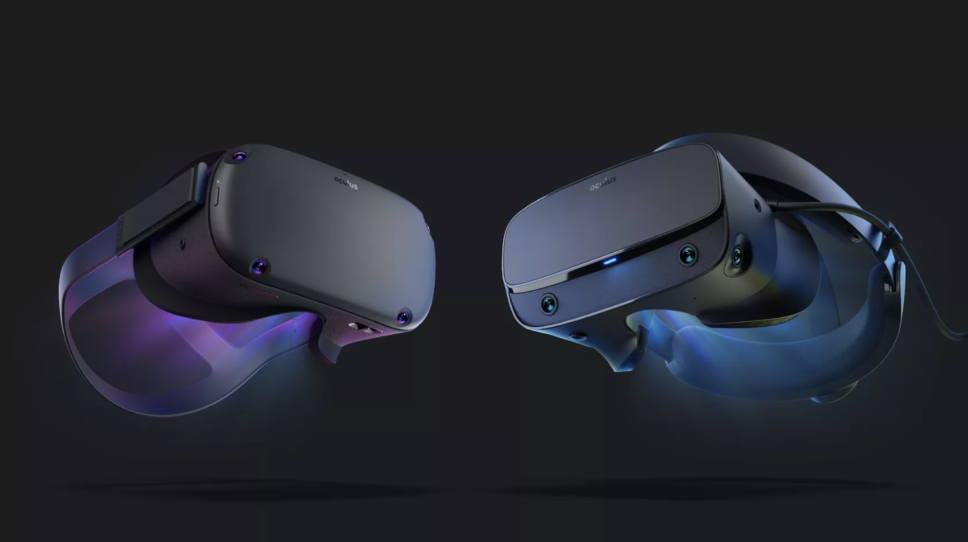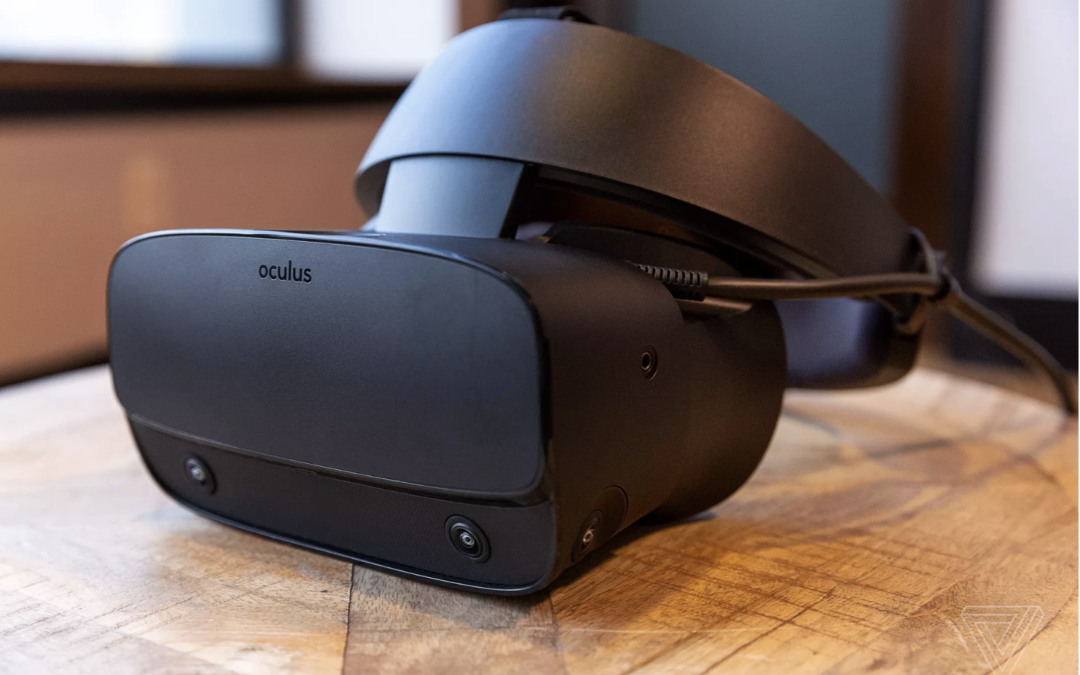Oculus VR unveiled its next-generation Rift headset today, a higher-resolution pair of virtual reality goggles that remove the need for external cameras by incorporating built-in tracking. The name of the device, as rumored by numerous reports over the last 12 months, is the Oculus Rift S. In a surprise twist, it’s been developed in partnership with Lenovo. Oculus says it struck a deal with the Chinese electronics giant to help it speed up manufacturing and to improve upon the design of the original Rift.
The result is a new VR device that is more comfortable, sports 2560 x 1440 resolution (or 1280 x 1440 per eye), and features the same inside-out tracking system that will ship on Oculus’ upcoming standalone Quest headset, which the company calls Oculus Insight. That way, you won’t need cumbersome cameras to enable full-body movement.
In another twist, both the Quest and Rift S device will cost exactly the same at launch: $399, with the same pair of slightly modified Touch motion controllers included and the same integrated audio system (plus a headphone jack for external audio). That decision makes it clear that Oculus wants its VR platform to offer a choice not between two vastly different pieces of hardware, but by the more simple determination of whether you have the hardware to power PC-grade VR.
“It’s really an option of whether you have a PC or not, and do you want to buy a PC or not,” says Jason Rubin, Facebook and Oculus’ vice president of VR partnerships, when speaking to a group of reporters during the Game Developers Conference in San Francisco. “Quest users will be a little more casual — more like a console player.”
According to Rubin and Nate Mitchell, Oculus’ head of VR product, every existing and future game on the Rift platform will be playable on the Rift S. The company is also enabling cross-buy and cross-play features. That way, you can buy a Quest and, at a later date, upgrade to a Rift S and still have your entire library intact. Additionally, Rubin says, multiplayer games that support both platforms will let players play one another, regardless of whether you’re playing on a Quest or Rift device.
One new feature coming to the Quest and Rift S platforms that looks particularly helpful is Passthrough Plus, which is a way to view the real world around you as you set up your space using Oculus’ Guardian tool (the blue mesh barrier that prevents you from walking into your desk or tripping over a chair). Because both headsets have inside-out tracking, you’ll be able to toggle between the Oculus Home launcher and live video feed of your real-life surroundings.
Sectioning off an area of your bedroom or living room for VR is now as easy as tracing the space with a Touch controller while you’re wearing the headset, instead of doing so on your computer during the more complicated camera setup process required with the original Rift. (Microsoft first added passthrough video capabilities to Windows Mixed Reality last year.)
We don’t have release dates for the Rift S or the Quest just yet. But Mitchell says both are shipping this spring, and it’s likely they’ll both arrive on the market at roughly the same time, although he was careful to stress that they may not launch on the exact same date.
As for the design, the Rift S features both Oculus and Lenovo branding as well as a new halo-style strap you’re likely familiar with if you’ve ever seen or worn a PlayStation VR headset. The halo strap makes for a more comfortable fit, and it allows you to dial the device forward and backward using a knob at the rear of the band. The top strap is there to make it snug on your head, while a slider underneath the right side of the headset is used to bring the physical lenses closer or farther from your eyes. Adjusting pupillary distance can now be done through a software setting, Oculus says.
Beyond the higher-resolution display and halo strap, the Rift S also features an additional fifth sensor not found on the Oculus Quest. Mitchell says this is to “increase tracking volume to maximize compatibility with the existing Rift content library.” But the primary difference between the original Rift and the Rift S will be the built-in tracking and the resolution bump; the standard Rift has 1080 x 1200 resolution per eye, while the Rift S has 1280 x 1440 per eye. (The Quest, on the other hand, features 1600 x 1440 per eye with an OLED panel.) In fact, the Rift S is using the same fast-switch LCD display as the standalone Oculus Go, but of course, channeling higher-fidelity visuals thanks to the tethered high-end gaming PC it requires to run.
That said, Oculus doesn’t want Rift users to upgrade their PCs unless they really want to. To achieve the same minimum spec requirements for PC-grade VR, Oculus is lowering the refresh rate on the Rift S from 90 Hz to 80 Hz, a tradeoff Mitchell says helps them keep the requirements in line. “We strive to keep the specs the same because we didn’t want the user who’s loving their Rift to need to buy a new PC,” he says.
Oculus plans to begin phasing out the original Rift when the Rift S launches later this year. But with the cross-buy and cross-play features in place, Mitchell and Rubin aren’t too worried about the transition. One hiccup the duo says the company is working through is the approval process for the Rift versus the Quest. As it stands now, Oculus is requiring developers to submit a proposal to launch on Quest, while Rift users will continue being able to self-publish.

The change, first reported last month, generated some negative reactions from consumers and developers, but Rubin says it’s a quality-control measure. “PC users want to experiment with new things,” he says. Quest users, on the other hand, will likely want a more controlled experience. Putting aside that developer-side difference, many of the same titles will be available on both platforms when they launch this spring, including the excellent rhythm lightsaber game Beat Saber and a competitive Western-themed online shooter called Dead & Buried 2, based on a demo Oculus built to show off Quest last year at its Connect conference.
There are two exclusive Oculus Studios games coming to the Rift S at launch, but not the Quest. The first is Asgard’s Wrath, a new combat-focused game set in the world of Norse mythology from Marvel Powers United VR developer Sanzaru Games. The other is Stormland, Insomniac Games’ new open-world VR title that puts you in the body of a sentient robot exploring an alien planet.
Although Oculus appears to be keeping the launch window for Rift S and Quest under wraps until close to release, we may not have to wait too long. Facebook’s F8 developer conference is set to kick off April 30th, and there’s speculation that the devices could launch, or at the very least receive imminent release dates, during the F8 keynote address.

